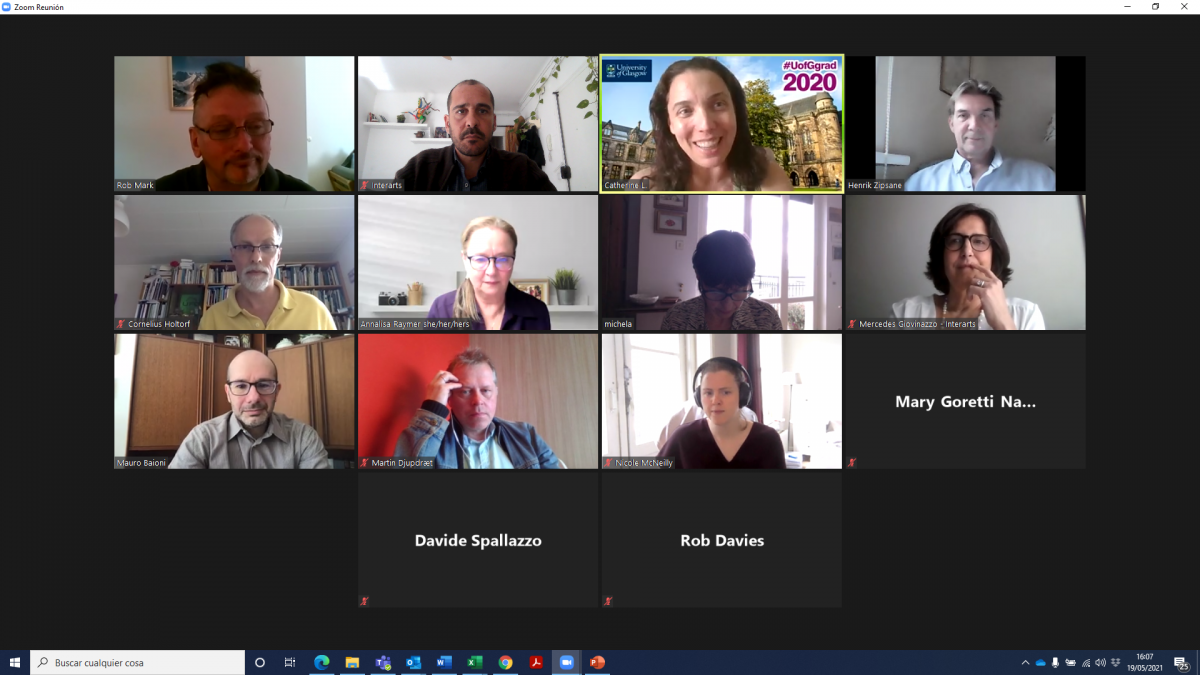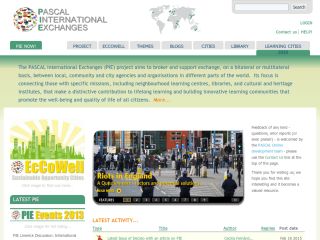Workshop on Cultural Heritage and Impact Assessment: Report for the second online workshop, 19 May, 2021
*** UPDATED ***
This joint meeting was the second online workshop and third cross-organisation meeting between PASCAL International Observatory (Learning City Network on Cultural Heritage Education), the European Museums Academy (EMA), and SoPHIA – a project aiming to further promote collective reflection with the cultural and political sectors in Europe on the impact and quality of interventions in the European historical environment and cultural heritage at an urban level to promote a holistic impact assessment model, indicators, and standards.

Participants attended from more than a dozen countries around the world, from Uganda, Nigeria, Argentina, Austria, Estonia, Brussels, Sweden, Denmark, Cyprus, UK and beyond. Diverse stakeholders including those working in cultural heritage specifically as well as involved in museum, urban planning, psychology and adult learning more broadly, and represented diverse organisations, not only PASCAL, European Museum Academy (EMA), and the SoPHIA EU Horizon project coordinating University - Roma Tre, and the Interarts Foundation in Barcelona, but also for example.... Linnaeus University in Sweden, Politecnico in Milan, University of Technology in Cyprus, and The Old Town Museum in Denmark.
Henrik Zipsane offered a warm welcome as Director of the European Museum Academy and PASCAL Associate, and Rob Mark opened the workshop with an introduction to PASCAL Learning City Network strands, as Coordinator of PASCAL’s LCN provided as well as a brief introduction to the organisation aims overall.
Mercedes Giovinazzo offered the first presentation as Director of Interarts, presenting the background information and rationale behind the SoPHIA project, on behalf of its consortium including Roma Tre University, Interarts in Barcelona, NTNU in Athens, EMA in Den Haag, IMRO in Zagreb, EDUCULT in Vienna, and IADT in Dublin. Mercedes introduced the major objective of drafting the Holistic Cultural Heritage Impact Assessment model but also its further aims of the project, namely to establish a platform for further developing the impact assessment model for different purposes and users. Mercedes reminded participants of the importance of cultural heritage interventions as an additional pillar or sustainable development and urgently in need of impact assessment, specifically as regards its impact on people (how do they live and related to heritage), time (longitudinally how do we sustain intervention impacts), and domains.
Mauro Baioni spoke second, in his role as Researcher at Roma Tre University, and presented on the challenges and solutions for developing the SoPHIA draft model of impact assessment. He noted the importance of embedding impact assessment across the lifetime of cultural heritage interventions and recalled the key concept of legacy- and how the past is informing and opening ways to the future. Mauro noted the challenges of creating a simple tool for capturing such complex outcomes, as well as being holistic, applicable across contexts, but also culturally specific. He proceeded to outline the 9 themes and 50 sub-themes, available as a grid. One Cornelius Holtorf participant picked up on the notion of assessing counter-cultural or counter-intuitive cultural impacts as an area for future discussion, although the model accounts for cross-cutting questions of accessibility/ exclusion and helpful/ harmful outcomes. Showing the global application of the model, particularly when use with case studies of better and weaker practice, noting that our failures often teach us more than our successes.
A group discussion then ensued, moderated by Rob Mark, by Cornelius Holtorf, to question- how do we know what is best or better practice? How can we measure success of say Social Cohesion? To which Henrik Zipsane acknowledge that qualitative and quantitative metrics were not perfect, that none existed and therefore even operationalising these 50 sub-themes is a step towards capturing impact. Martin Djupdraet further prompted regarding the model or mixed-methods model more specifically, to which Mauro replied they were working toward a meta-model to first agree on what needs to be included in the panel, to paint a holistic and shareable picture, to capture from small to great interventions, then the field can move beyond simply visitor growth.
Annalisa Raymer asked about the role of participant stakeholders in the development of the model, as well as the impact, to which Mercedes outlined the nature of participant focus groups and participation in operationalising the themes, but more importantly, the ongoing process of stakeholder involvement in applying the model (e.g. museums stakeholders, or participant visitors) and how they might apply and adapt the model to meet their impact needs, but more important the project about producing dialogue around the model- operational, policy, communities of practice, and the ongoing conversations of development and knowledge exchange here. Michela Marchiori further offered that Sophia offers two novel directions in impact assessment modelling, the first is about structure of model, but also articulation of themes and sub-themes of importance as a grassroots developed model, but to be implemented by users to assess their intervention. The second is the inclusion of stakeholders in the discussions of impact assessment model, creating discussions of how to include ‘end users’ as participatory actors with the impact assessment model- as all institutions and organisations, and individual interviews/ case studies were involved in reflective process along the project journey, leading the team to further reflections of participatory role of end users in model implementation.
After a lively and extended discussion of the first three presentations we proceeded to the final talk offered by Henrik Zipsane as Director of the European Museum Academy, but also in his role as Coordinator of the PASCAL LCN Harnessing Museums, Heritage and Education. Henrik presented on the Nationalmuseum as well as the Jamtli project as a case study example, where he applied the 9 themes to evaluate this museums innovation of a local museum hosting a National museum. The project was executed 2010-2018 with the official aim to make high quality art experiences accessible for people in the North of Sweden, but also to stimulate a growth in tourism. The presentation went through the nine aspects of the assessment model and showed examples on which kind of information use of the model brought to daylight in a structured way. The example also illustrated that there were impacts which goes beyond such a model, and the main example here was the political impact based on the pride in the region for hosting a national treasure context.
Group discussion there ensued where Rob Davies asked about the extent to which government support and funding would be increased with more quantitative numbers, to which Henrik agreed that both numbers and profit matter greatly to government, local government, and funders. This was followed by Nicole McNeilly’s questions about practice and practicability, as to whether organisations might have the capacity and costs for implementing this impact approach qualitatively and quantitatively. To which Cornelius further added that until tools were available for easy implementation, without a huge need for further training and support, impact assessment may not have a wide uptake. And Martin furthered this discussion of thinking well-being in a wider context, social, economic, global- and wondered if other metrics and models could be contrasted with the present model, and this might encourage wider usage.
Rob mark then invited Henrik to address these final discussion points, where he pointed out the counter-effects of the case study- for instances, the tension of sports-national/ regional museums in media coverage. Once opened, there are always defences of spend and cuts, which are often not populate. Rob then closed the meeting with a discussion of next steps, including Alberto’s introduction of the future of the project’s website and online engagement for developing further communities of practice.
PASCAL and EMA will continue to host workshops, such as these in conjunction with Sophia, and invite existing and new participants to contribute to our Learning City Networks. We extend an open invitation to participate in our future LCN and SIG meetings of the Pascal international Observatory as regards Cultural Heritage, Education and Cultural Literacy.
Catherine Lido, Henrik Zipsane & Rob Mark
Agenda
- Welcome and introductions
- Introduction to SoPHIA
- Presentation of the draft Holistic Cultural Heritage Impact Assessment model
- Group discussion
- Presentation of the Nationalmuseum - Jamtli project as case study
- Group discussion • Moderated by Henrik Zipsane
- Next steps and closing session
Non-presenting Participants (Synchronous and Asynchronously viewing)
|
Martin |
Brandt Djupdraet |
Chief Curator |
Museum Den Gamle By |
|
Davide |
Spallazzo |
Assistant Prof., Department of Design |
Politecnico di Milano |
|
Cornelius |
Holtorf |
School of Cultural Sciences |
Linnaeus University |
|
Pirjo |
Hamari |
Director of Department / Coordinator |
Finnish Heritage Agency / MOI project |
|
Nicole |
Mc Neilly |
Impact Advisor |
Europeana Foundation |
|
Annalisa |
Raymer |
Director, Community Learning and Service Partnerships / Cornell’s Adult Education Program for Mutual Learning |
Cornell University |
|
Federica |
Santagati |
Prof. of Museology |
University of Catania |
|
Mary |
Goretti Nakabugo |
Executive Director |
Uwezo Uganda (NGO) |
|
Ienveniia |
Dragomirova |
Associated prof. of tourism department |
Donetsk State University of Management in Mariupol City |
|
Irina |
Noha |
Rectors Assistant |
Donetsk State University of Management in Mariupol City |
|
Victoriya |
Davva |
Head of Department of Tourism Development |
Mariupol City |
|
|
|
|
|
|
Mardarida |
Loran |
Consultant on Museums |
regularly works for the Government of Catalonia |
|
Robert |
Davis |
Research Associate at the Digital Heritage Research Laboratory |
Cyprus University of Technology |
|
Vice-Chair |
Europeana Network Association |
||
Speaker Participants Rob Mark Catherine Lido Mercedes Giovinazzo Alberto Cerezo Mauro Baioni |
|
|
|
|
|
|
||
|
|
|
||
|
|
|
||
|
|
|
||
|
|
|
||
| Attachment | Size |
|---|---|
| 210519_sophia_-_nationalmuseum_jamtli_case.pdf | 861.2 KB |
 Printer-friendly version
Printer-friendly version- Login to post comments






